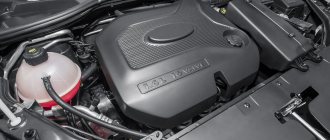In 2021, at the Innoprom exhibition in Yekaterinburg, AvtoVAZ presented its new sedan - Lada Vesta CNG (Compression Natural Gas). This is a unique dual-fuel factory car for the Russian market. The Vesta Cng project is supported at the state level and not only - many structures are interested in using ecogas as fuel. The Ecogas program is a government subsidy received in the form of a rebate for the purchase of a car fueled by natural gas. In the case of the Lada Vesta, this amount is 140 thousand rubles, which the state pays to the plant for you. The price of the car for the 18th year (and the Ecogas program has been launched again) in the Classic / Start configuration starts from 649,900 rubles, Comfort from 677,900 rubles, Luxe from 740,900 rubles, Luxe / Multimedia - 768,900 rubles.
To understand what kind of car this is, let’s compare it with the same petrol Lada Vesta sedan and with a car converted for LPG. Unlike the last two options, with Vesta Cng you can refuel with both gasoline and methane. You can manually switch the car to one of the types of fuel, and if the gas runs out, the system automatically switches to liquid fuel.
- Dimensions of the new body with gas equipment and other characteristics
- Propane or methane
- Pros and cons of methane gas treatment
- Available cng colors
- What body type does cng come in?
- What distinguishes the new salon review vesta cng
- Photo of the cylinder in the trunk
- Bi-fuel system gas and gasoline
- Consumption and range on gas Vesta cng
- How to choose the right gas cylinder for Lada Vesta
- Look at the test drive of lada vesta cng modifications
- Advantages and disadvantages of Vesta cng
- Flaws
- What are the benefits
- HBO can be supplied to the service center for any modification
Dimensions of the new body with gas equipment and other characteristics
Vesta cng is equipped with a VAZ 21129 engine. This is a 1.6-liter engine with a capacity of 106 horsepower and a torque range of 135 Nm. Vesta is available in four trim levels with different levels of comfort. All Cngs come off the production line with a 5MT manual transmission. When using different fuels, only acceleration will differ (on gas - 12.9, on gasoline - 11.8 seconds from 0 to 100 km/h). Maximum speed (methane - 170, liquid fuel - 175). The description of the external technical characteristics of CNG is no different from the parameters of a regular Lada Vesta, except for the presence of an additional filler hole under the gas tank cap. All dimensions of Vesta remained the same (length - 4410 mm, width - 1764 mm, height - 1497 mm, ground clearance - 178 mm, gas tank volume - 55 liters).
Power reserve, gas consumption, cost of methane at gas stations
Thanks to the rather significant volume of the gas tank (55 l) and gas cylinder (90 l, 20-21 m3 of gas), the Lada Vesta is able to cover long distances without refueling, which is an excellent advantage for traveling long distances. On average, a vehicle can travel up to 400 km on a full gas tank, and about 1000 on a full gas tank.
Fuel consumption is directly related to the operating conditions of the car:
- in the urban cycle, Lada Vesta CNG consumes about 10 liters of gasoline and 8 liters of gas;
- in the suburbs, the figures vary from 6 liters (gasoline) to 5 liters (gas);
- with a mixed car it will consume 7.5 liters per 100 km driving on gasoline, 6.5 liters on methane.
The efficiency of the vehicle is undeniable, because the price of methane is significantly lower than its opponents (propane and gasoline). At gas stations in Russia, the cost of natural gas varies from 13 to 18 rubles.
Propane or methane
Initially, all Lada Vesta engines were designed with great potential for various modifications, including the installation of other power plants. New Vesta is immediately produced with two fuel systems - using gasoline and using natural compressed gas. Lada uses only methane. It is less explosive than propane and complies not only with existing European toxicity standards, but also with their prospects. Compressed natural gas reduces fuel costs by 3.5 times and increases engine life.
Methane Lada Vesta CNG - what is it?
The bi-fuel system is a kind of hybrid of gasoline and gas. The prefix stands for Compression Natural Gas. It is noteworthy that the cost of remaking a standard car will cost approximately 170 thousand rubles. However, as part of government support, VAZ is partially sponsored for conversion. Therefore, new models from the factory will be only 30 thousand more expensive.
Pros and cons of methane gas treatment
Lada Vesta on methane is a very economical car. The manufacturer claims that Vesta is capable of traveling 1000 km without refueling. It turns out that less fuel is consumed than usual, while at the same time methane costs 4 times less than 95 gasoline, which is recommended to fuel the new Lad family. One kilometer of travel on gas costs 1 ruble.
The life of the engine is extended due to the gaseous state of the fuel. Liquid fuel washes away the oil film from the walls of the cylinder liners, forms deposits - sooner or later carbon deposits appear. Methane has completely different properties - it does not affect the components of the engine in any way. However, natural gas reaches high temperatures. To cool the air-fuel mixture, and with it the space above the piston, the system provides for rare injection of gasoline while driving on LPG. This engineering solution also increases the resource of the engine, protecting it from overheating. The Lada starts with gasoline, only then the gas is connected - this is done because the engine and gas need to warm up a little.
Methane tends to dissipate, it is not heavy and does not accumulate in lowlands. From this point of view, if it leaks, it is safer than any other fuel. The entire fuel line is built safely: from the spherical gas cylinder (this shape is preferable for methane) to the controller in the engine compartment. It shuts off the gas at any even slightly increased flow rate.
A big plus is that such gas-cylinder equipment is factory-made, that is, it has a guarantee, and there will be no problems with it in the registration of the car. There is no need to modify the mechanical part of the engine to accommodate it, and there is no risk of unsuccessful installation of gas equipment. A good bonus to this is the filling nipple located in the gas tank flap (on non-factory systems it is in the trunk).
Refilling with methane is quick, about 10 minutes. This time depends on the operating pressure at the filling station, the ambient temperature and the fullness of the gas tank. By the way, the operating temperature for methane is from -40 to +55 degrees Celsius.
The biggest disadvantage of this Vesta is the low density of methane CNG filling stations (automobile gas filling compressor stations) throughout Russia. More often than not, such gas stations are geographically located near the methane pipeline, and these are far from the most convenient places.
The cylinder in a sedan takes up a lot of space both in the trunk and in the rear of the cabin. Because of it, the backs of the seats do not recline, a couple of bags can fit on the shelf, and several bottles of water can be stored in the trunk.
What are the advantages of the methane version of Lada Vesta
The first samples of the modified car were presented by the plant in mid-2014 and caused a sensation due to the presence of a foreign-made factory gas installation and the possibility of using two fuel systems. Mass production of the model range started only in 2021.
The advantages of the methane version are:
- bringing the toxicity level to international standards;
- significant reduction in fuel costs (subject to the use of gas equipment);
- increasing the travel distance to 1000 km on a full tank;
- greater safety of methane compared to propane and butane;
- less wear of power plant mechanisms.
One of the main advantages, of course, is considered to be efficiency, especially when it comes to regular use of the car and driving long distances. This model has no external differences from the previous version, except for special markings in the trunk area, indicating that the car uses methane. Convenient for daily use, front-wheel drive sedans and station wagons are distinguished by a slightly higher price due to the dual-fuel system. However, economical fuel consumption and a lower price for methane offset this fact.
Photo of the cylinder in the trunk
and a photo of the cylinder and the gas line leading from the interior of the Lada Tsng (the rear seat has been removed).
Bi-fuel system gas and gasoline
The Lada Vesta with LPG leaves the AvtoVAZ assembly line as a regular gasoline sedan, then it is sent to Togliatti to a separate production facility of the ATS Group, where the inner half of the luggage compartment is disassembled. A methane cylinder, fuel lines, gas injectors are installed, a hole is made in the gas tank hatch, the “brains” are reflashed, the phased intake is adjusted, etc. The holes made in the metal are puttied, processed and painted. A plastic casing is installed for aesthetics and protection. Gas equipment is pressure tested and tested.
Converting Vesta into a dual-fuel Lada Vesta cng costs 170 thousand rubles. As part of the Ecogas program, the price of methane Vesta will be only 30 thousand more expensive.
The new Lada is fueled with natural gas methane. At a gas station, the pressure is 200-300 atmospheres, while the working pressure in the cylinder is 20 MPa at an average temperature of -15 degrees. After refueling, you need to release the pressure. It's done like this. Once the filling is finished, you need to leave the filling connection of the cylinder connected to the station for a while - the pressure will be released automatically. The design of Vesta's gas equipment provides for emergency release of pressure - a gas pipe with a free end goes from the tank under the car.
Let us briefly consider what other structural elements the ATS methane installation consists of. There are two main gas lines from the metal composite cylinder. One is led through the bottom of the car to the main power unit, here it is supplemented by a gas reducer, an injection ramp with nozzles, and an intake module. The second gas line goes to the right to the refueling hatch. In the path of the fuel lines there is a filter, a controller and a filling device (fitting).
Prices and modifications of Lada Vesta on methane
At the present stage, the methane Lada Vesta is available in the following trim levels:
Classic - the basic version is equipped with two airbags, anti-lock braking system, electronic dynamic stabilization system, climate control equipment, electronically adjustable heated exterior mirrors, 15-inch metal wheels, brake force distribution system, electronic cruise control, traction control, hill start assist system , heated driver and passenger front seats. The price of the basic configuration starts from 600 thousand rubles.
Comfort - manufacturers have added a number of additional functions to the basic configuration: expanded ability to adjust the driver's seat, parking sensors, and a fairly powerful audio system. The price of the modification is about 640 thousand rubles.
The Luxe version includes power windows for the rear windows, additional side airbags, and sensors that respond to light and rain. Among other things, the version is equipped with alloy wheels with a diameter of 16 inches. For this modification, manufacturers ask from 700 thousand rubles.
Luxe Multimedia is the most expensive modification (from 730 thousand rubles). This version is equipped with a built-in navigation system, a 7-inch touch screen, six high-quality speakers, and multifunction steering.
How to choose the right gas cylinder for Lada Vesta
The Sinoma metal composite cylinder, produced in China (not everything Chinese is bad) with a volume of 90 liters and a capacity of up to 22 cubic meters of gas fuel, has proven itself to be excellent. Ball-shaped cylinder with a 15-year guarantee. The rules for its operation are simple: once every five years you need to undergo an inspection, turn off the valve during long-term cessation of operation, and do timely maintenance.
Vesta also uses gas equipment of the ItalGas and Emer brands. Everything is serviced under warranty at Lada dealerships.
Registration of the methane version of Lada Vesta with the Traffic Police
Lada Vesta CNG is a model range serially modified for LPG. The registration procedure for the methane version of the Lada Vesta does not differ significantly from the registration of the gasoline version. The vehicle's passport must initially contain a note stating that the car's engine is dual-fuel, but the registration certificate (CTC) may not contain a record of gas equipment. However, it is better for the car owner to insist that the STS and special notes must include a clause regarding the presence of LPG.
Advantages and disadvantages of Vesta cng
Like any gasoline car, the gas Lada has its drawbacks. We consider the main thing: a small number of refills. It’s a matter of time, but for now this is a big minus. We consider the main advantage of the gas modification to be savings on fuel.
Flaws
The Lada cng has catastrophically little space in the trunk (460 instead of the usual 920 mm), as well as on the shelves behind the rear seats. The entire space for long luggage was taken up by a gas storage tank. The cylinder weighs like decent luggage - 75 kg, making Vesta a little heavier, reducing its dynamic characteristics.
Minor disadvantages include the lack of protective covers on the fuel pipes running under the bottom. The note also applies to other Vesta models. The spare wheel in the Lada cng is recessed under the cylinder, now it is more difficult to get it out. The kit does not include a normal adapter for the filling fitting. Maintenance at the dealer will cost more than for gasoline cars, since additional items are added to the technical card plus replacement of the gas fuel filter.
On the Lada Tsng, only one type of transmission is possible - 5MT, although the manufacturer stated that they also promise to supply 5AMT (robot) in the future. When using gas as fuel, the acceleration dynamics drop, the power produces 96 horsepower and 135 Newtons per meter of torque. If you feel that this is not enough for you, you can switch to gasoline.
There are few methane gas stations in Russia. According to Gazprom Gas Engine Fuel, there are about 320 of them, and another 60 will be completed. The situation is somewhat saved by mobile gas tankers (PAGZ). They mainly serve routes for commercial transportation and carry 16 cylinders with 5,000 cubic meters of methane. There are also few mobile refueling stations. However, the prospect of development of this direction is clear. After all, AvtoVAZ has several more natural gas vehicles in its projects.
What are the benefits
1) The engine speed of the VAZ 21129 on methane remains the same: 800-900 - idle, 5800 - maximum. The Cng feels like it pulls just like a petrol Lada.
2) Refilling with methane is faster than refueling with other gas, for example, propane.
3) HBO Lada Vesta is safe. Firstly, due to the properties of the gas itself. Secondly, the manufacturer carefully tests the system for leaks during operation and possible damage (all crash tests passed positively). Thirdly, the equipment was installed in the factory with a guarantee of quality and service life. Fourth, VTTS (vehicle type approval) has been obtained. You simply register the car in your name, without additional registrations.
4) Lada Vesta Tsng is very economical. A distance of 400 kilometers traveled on gas fuel saves you about 1000 rubles.
5) The price of the new Lada is only 30 thousand more than the standard one. The BRC gas system can be installed on any car, but self-installation is more expensive than purchasing a ready-made factory version of Vesta as part of state support.
What is the difference between propane and methane. The principle of operation of a methane engine
Propane and methane are gas-fuel substances that have the same purpose, but fundamentally different characteristics. Propane is a product of the oil industry, while methane is classified as a natural gas. When used as fuel for HBO, both gases are placed in cylinders, the thickness of the walls of which also depends on the substance for which they are intended.
Liquefied propane does not require excessively high pressure when filling the cylinder; accordingly, the walls of the propane storage are not too dense (4-5 mm). Methane is used only in gaseous form, and its pressure reaches extremely high levels. Methane cylinders are much larger in size, their walls are strong (2-3 cm). During combustion, methane is harmless to the environment, which is why it is recognized by world standards as the most environmentally friendly combustible fuel. The most important difference between the two categories of gases is the degree of their safety for the driver and passengers of the car. Methane, unlike propane, is light, which allows the substance to evaporate (if it leaks) before creating an explosive situation. Since methane has no color or odor, the gas is diluted with specific odorants that make it possible to identify a leak. In Russia, the lion's share of car owners prefer installing propane gas equipment due to its lower cost and the relative lightness of fuel cylinders. Methane equipment is much more expensive, but the price of methane, its environmental friendliness and operational safety cover this disadvantage. A methane engine operates on the same principle as a gasoline engine (the compressed mixture is ignited by an energy source) with one fundamental difference - an increased level of compression. The source of fuel supply is a gas cylinder, which is installed in the trunk of the car and is equipped with a special valve, through which both the equipment is refueled and gas is supplied to the system.











